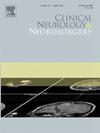Intravenous versus oral tranexamic acid in elderly transforaminal lumbar interbody fusion patients: A prospective cohort study
IF 1.8
4区 医学
Q3 CLINICAL NEUROLOGY
引用次数: 0
Abstract
Background
Tranexamic acid (TXA) can effectively reduce intraoperative blood loss and transfusion rates. However, in spinal surgery, the number of surgical levels can significantly influence intraoperative and postoperative bleeding, particularly among the elderly, contributing to the persistently high rate of transfusion during the perioperative period. To verify the safety and efficacy of different application methods of TXA in elderly patients undergoing transforaminal lumbar interbody fusion (TLIF), a prospective cohort study was conducted.
Methods
A total of 958 patients undergoing TLIF were randomly assigned to receive 2 g of oral TXA two hours before surgery or 15 mg/kg of intravenous TXA 30 min before surgery, or to a control group. The samples were further divided into three categories based on the number of fused segments (one-level fusion, two-level fusion, and three-level fusion). The primary outcomes were the total blood loss and transfusion rate. Secondary outcomes included intraoperative blood loss, postoperative blood loss, drainage volume, time until drain removal, perioperative transfusion volume, length of stay, thrombotic events, and other adverse events.
Results
336 patients received intravenous TXA and 314 patients were received oral TXA. Patient demographic factors were similar between groups. In the one-level fusion surgery cohort, comparisons across the three groups revealed no statistically significant disparities in total blood loss, transfusion rates, or drainage volumes (P > 0.05). In both two-level and three-level fusion surgeries, patients administered with TXA experienced a notably reduced perioperative bleeding compared to the control group (P < 0.01). Interestingly, a significant disparity was observed in the drainage volumes between the intravenous and oral administration groups (P = 0.026), specifically within the context of two and three-level fusion procedures.
Conclusion
In elderly patients undergoing TLIF surgery, both intravenous and oral administrations of TXA are safe and effective. Oral TXA, being more economical and non-invasive compared to intravenous injection, holds promise for clinical use.
经椎间孔腰椎融合术老年患者静脉注射与口服氨甲环酸的比较:前瞻性队列研究。
背景:氨甲环酸(TXA氨甲环酸(TXA)可有效减少术中失血和输血率。然而,在脊柱手术中,手术层次的数量会显著影响术中和术后出血,尤其是在老年人中,这也是围手术期输血率居高不下的原因之一。为了验证经椎间孔腰椎椎体间融合术(TLIF)老年患者应用 TXA 不同方法的安全性和有效性,我们开展了一项前瞻性队列研究:共有 958 名接受 TLIF 的患者被随机分配到术前 2 小时口服 2 克 TXA 或术前 30 分钟静脉注射 15 毫克/千克 TXA 或对照组。样本根据融合节段的数量进一步分为三类(一级融合、二级融合和三级融合)。主要结果是总失血量和输血率。次要结果包括术中失血量、术后失血量、引流量、拔除引流管前的时间、围手术期输血量、住院时间、血栓事件和其他不良事件:336名患者接受了静脉注射TXA,314名患者接受了口服TXA。两组患者的人口统计学因素相似。在一级融合手术队列中,三组患者在总失血量、输血率或引流量方面的差异无统计学意义(P > 0.05)。在两级和三级融合手术中,与对照组相比,使用 TXA 的患者围手术期出血量明显减少(P < 0.01)。有趣的是,静脉注射组和口服组的引流量存在明显差异(P = 0.026),特别是在两级和三级融合手术中:结论:对于接受 TLIF 手术的老年患者,静脉注射和口服 TXA 均安全有效。与静脉注射相比,口服 TXA 更经济、无创伤,有望用于临床。
本文章由计算机程序翻译,如有差异,请以英文原文为准。
求助全文
约1分钟内获得全文
求助全文
来源期刊

Clinical Neurology and Neurosurgery
医学-临床神经学
CiteScore
3.70
自引率
5.30%
发文量
358
审稿时长
46 days
期刊介绍:
Clinical Neurology and Neurosurgery is devoted to publishing papers and reports on the clinical aspects of neurology and neurosurgery. It is an international forum for papers of high scientific standard that are of interest to Neurologists and Neurosurgeons world-wide.
 求助内容:
求助内容: 应助结果提醒方式:
应助结果提醒方式:


